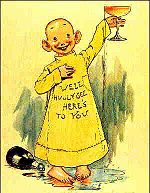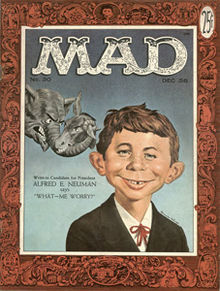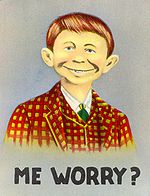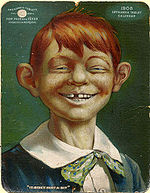- Alfred E. Neuman
-
For other uses, see Alfred Newman (disambiguation).
Alfred E. Neuman is the fictional mascot and cover boy of Mad magazine. The face had drifted through American pictography for decades before being claimed and named by Mad editor Harvey Kurtzman. He currently appears in the animated Mad.
Contents
History
Since his debut in Mad, Neuman's likeness, distinguished by jug ears, a missing front tooth, and one eye lower than the other has graced the cover of all but a handful of the magazine's 500 issues. His face is rarely seen in profile; he has virtually always been shown in full frontal view, directly from behind, or in silhouette. Harvey Kurtzman first spotted the image on a postcard pinned to the office bulletin board of Ballantine Books editor Bernard Shir-Cliff. "It was a face that didn't have a care in the world, except mischief," recalled Kurtzman. Shir-Cliff was later a contributor to various magazines created by Kurtzman.[1]
In November 1954, Neuman made his Mad debut on the front cover of Ballantine's The Mad Reader, a paperback collection of reprints from the first two years of Mad. The character's first appearance in the comic book was on the cover of Mad 21 (March 1955), as a tiny image as part of a mock ad. A rubber mask bearing his likeness with "idiot" written underneath was offered for $1.29.
Neuman's third appearance was in the illustrated border of the first magazine version of Mad #24 (July 1955) with his now-familiar signature phrase "What, me worry?" written underneath. Initially, the phrase was rendered "What? Me worry?" This border would be used for five more issues, through Mad #30 (December 1956).
The character was also briefly known as Mel Haney. In Mad #25, the face and name were shown together, on separate pages, as both Alfred E. Neuman and Mel Haney. The crowded cover shot on Mad #27 marked Neuman's first color appearance.
In late 1956, Neuman's identity became fixed, when he appeared on the cover of Mad #30 as a supposed write-in candidate for the Presidency. His features, which had first been rendered in black-and-white by Will Elder, were fine-tuned and recreated in color by Norman Mingo. It was this image which became the character's defining portrait. In November 2008, Mingo's original cover art featuring the first "official" portrait of Neuman sold at auction for $203,150.
Beginning with issue 30, and continuing to the present day, Neuman has appeared on the cover of every issue of Mad and its spinoffs, in one form or another, with a small handful of exceptions. One such departure was Mad #233 (September 1982) which replaced Neuman's image with that of Pac-Man.
Mingo painted seven more Neuman covers through 1957 and later became the magazine's signature cover artist throughout the 1960s and 1970s, although Frank Kelly Freas rendered Neuman for Mad from 1958 to 1962. A female version of Alfred, named Moxie Cowznofski and occasionally described in editorial text as Alfred's "girlfriend," appeared briefly during the late 1950s. Alfred and Moxie were sometimes depicted side-by-side, defeating any speculation that Moxie was possibly Alfred in female guise. Her name was inspired by Moxie, a soft drink manufactured in Portland, Maine, which was sold nationwide in the 1950s and whose logo appeared in many early issues of Mad.
In late 1959, Mad released a 45 rpm single entitled "What - Me Worry?" on ABC Paramount 12013 that was credited to Neuman, and featured an uncredited voice actor singing the song as Neuman. (The B-side of the single, "Potrzebie", is an instrumental.)
Mad routinely combines Neuman with another character or inanimate object for its cover images. Neuman has appeared in a slew of guises, including Santa Claus, Darth Vader, George Washington, King Kong, Baby New Year, Lawrence of Arabia, Batman, Robin, Spider-Man, Maharishi Mahesh Yogi, Rosemary's Baby, George S. Patton, the Fiddler on the Roof, an Aurora-style model kit, Alex from A Clockwork Orange, Bonnie and Clyde actor Michael J. Pollard, Barbra Streisand, Mr. T, Indiana Jones, Radar O'Reilly, Bruce Springsteen, Mr. Spock, Bart Simpson, Pee Wee Herman, Michael Jackson, a California Raisin, a face on Mount Rushmore, as Egyptian hieroglyphics, part of a fireworks display, a jack-in-the-box, an engraved bottle stopper, a scarecrow, the Headless Horseman, Don King, Robin Hood, Abraham Lincoln, Guns N' Roses' Slash, the Man in the Moon, an Oscar statuette, an "Operation" board game, Jabba the Hutt, Wolverine, Gollum, SpongeBob SquarePants, Agent Smith from The Matrix, Kurt Cobain, Shrek, Dr. Octopus, Dennis Rodman, The Incredibles' Jack-Jack, a zombie, a caveman, a fetus, a boa constrictor, a rat, a weathervane, a Ferengi, Greek column, the joker in a deck of cards, the bull's eye in a target, the three wise monkeys, part of a totem pole, a cigar label, George W. Bush, Justin Timberlake, Harry Potter, Lord Voldemort, Barry Bonds, Suri Cruise, Wilson the Volleyball, the Mona Lisa, Che Guevara, Lil Wayne, Barack Obama, Rorschach (from Watchmen), Adolf Hitler and Uncle Sam ("Who Needs You?"), among other familiar faces.
Since his initial unsuccessful run in 1956, he has periodically been re-offered as a candidate for President with the slogan, "You could do worse... and always have!"
Despite Neuman's ubiquity as a grinning cover boy as the magazine's circulation quadrupled, the single highest-selling issue of Mad depicted only his feet. The cover image of issue #161,[2] spoofing the 1973 film The Poseidon Adventure, showed Neuman floating upside-down inside a life preserver. The original art for this cover was purchased at auction in 1992 for $2,200 by Annie Gaines, the widow of MAD founder and publisher William Gaines, and subsequently given on permanent loan to MAD writer Dick DeBartolo.[3]
To date, only a dozen Mad covers have not depicted Alfred E. Neuman since his appearance on issue #30, the most notorious being the controversial cover to #166. It declared Mad to be "The Number One Ecch Magazine," illustrating the claim with a human hand giving the profane "middle finger" gesture.[4] Some newsstands that normally carried Mad chose not to display or sell this issue.
Along with his face, Mad also includes a short humorous quotation credited to Neuman with every issue's table of contents. (Example: "It takes one to know one... and vice versa!") Some of these quotations were collected in the 1997 book Mad: The Half-Wit and Wisdom of Alfred E. Neuman, which was illustrated by Sergio Aragonés.
Neuman is now used exclusively as a mascot and iconic symbol of the magazine, but before this status was codified, he was referenced in several early articles. In one, Neuman answered a letter from a suicidal reader by giving "expert advice" on the best technique for tying a hangman's knot. Other articles featured the school newspaper of "Neuman High School," and a bulletin from "Alfred E. Neuman University." An article entitled "Alfred E. Neuman's Family Tree" depicted historical versions of Neuman from various eras. Since then, Neuman has appeared only occasionally inside the magazine's articles. A recurring article titled "Poor Alfred's Almanac" showed his face atop the page, but otherwise the character had no role in the text. In a 1968 article, Alfred's face was assembled, feature by feature, from parts of photographs of well-known politicos, including then-President Lyndon B. Johnson (left ear), Richard Nixon (nose), Oregon Governor Mark Hatfield (eyes), and Ronald Reagan (hair). The gap in his teeth (which was otherwise the grin of Dwight D. Eisenhower) came from "The 'Credibility Gap' Created by Practically All Politicians."
Neuman's famous motto is the intellectually uncurious "What, me worry?" This was changed for one issue to "Yes, me worry!" after the Three Mile Island accident in 1979. On the cover of current printings of the paperback The Ides of Mad, as rendered by long-time cover artist Norman Mingo, Alfred is portrayed as a Roman bust with his catch phrase engraved on the base, translated into Latin-- Quid, Me Anxius Sum?
Alfred E. Neuman's surname is often misspelled as "Newman."[5]
Alfred E. Neuman's most prominent feature is his gap-toothed grin, which has appeared on nearly every issue of Mad, with some notable exceptions. On the cover of issue #236 (January 1983), Neuman was featured with E.T. the Extra-Terrestrial. The cover showed E.T. using his famous "healing finger" to touch Alfred E. Neuman's mouth and cause the missing tooth to appear. The cover of issue #411 (November 2001), the first to be produced following the 9/11 attacks in the United States, showed a close-up of Neuman's face, but his gap was now filled with an American flag. A text gag on the cover of issue #263 (June 1986) claimed that the UPC was really a "Close-up Photograph of Alfred E. Neuman's Missing Tooth."
Neuman also appeared as himself in a political cartoon, after Newsweek had been criticized for using computer graphics to retouch the teeth of Bobbi McCaughey. The cartoon was rendered in the form of a split-screen comparison, in which Alfred E. Neuman was featured on the cover of Mad with his usual gap-toothed grin, then also featured on the cover of Newsweek, but with a perfect smile.
Despite the primacy of Neuman's incomplete smile, his other facial features have occasionally attracted notice. Artist Andy Warhol said that seeing Neuman taught him to love people with big ears.[6]
Genesis
 The Yellow Kid, 1897
The Yellow Kid, 1897
Neuman's precise origin is shrouded in mystery and may never be fully known. Printed likenesses can be traced back to the 19th century, such as The Yellow Kid, the 1890s character from Richard F. Outcault's strip, Hogan's Alley.
Nineteenth-century publications such as Punch and Puck featured illustrated caricatures which were based on pseudo-scientific physiognomy of the time, and which depicted the typical Irish immigrant as a bomb-throwing cretin barely distinguishable from the adult ape. Bigoted and humorous, these drawings soon supplanted the previous pictoral stereotype of the Irish bumpkin, and share similarities with the Neuman face. Prominent illustrators such as Joseph Keppler and Frederick Opper developed a carefree Irish couple who lived in squalor, yet were oblivious and content. These less threatening caricatures were soon adopted by advertisers to promote a variety of products.[citation needed]
Versions of the face were used as medical pictures of people with deficiency diseases or hormone imbalances; the faces of patients with Williams syndrome have been compared to Neuman.[7] Similar faces turned up in advertising for "painless" dentistry. A face virtually identical to Neuman's appears in the 1923 issue of the University of Minnesota humor magazine The Guffer above the caption "Medic After Passing Con Exam in P. Chem." Another identical face shows up in the logo for Happy Jack Beverages, a soda drink produced by the A. B. Cook company in 1939. An almost-identical image appeared as "nose art" on an American World War II bomber, over the motto "Me Worry?" (this painted face was sometimes referred to as "The Jolly Boy").[8] Neuman's image was also used negatively, as a "supporter" of rival political candidates, with the idea that only an idiot would vote for them. In 1940, those opposing Franklin Delano Roosevelt's third-term reelection bid distributed postcards with a similar caricature bearing the caption, "Sure I'm for Roosevelt". In some instances, there was also the implication that the "idiot" was in fact a Jewish caricature. Carl Djerassi's autobiography claims that in Vienna after the Anschluss, he saw posters with a similar face and the caption Tod den Juden ("Death to the Jews").
Since the EC editors had grown up listening to radio, this was frequently reflected in their stories, names and references. The name "Alfred E. Neuman" derived from comedian Henry Morgan's "Here's Morgan" radio series on Mutual, ABC and NBC. One character on his show had a name that was a reference to composer Alfred Newman (1901–70), who scored many films and also composed the familiar fanfare that accompanies 20th Century Fox's opening film logo.[9] The possible inspiration for Henry Morgan was that Laird Cregar portrayed Sir Henry Morgan in The Black Swan (1942) with Tyrone Power, and the Oscar-nominated score for that film was by Newman. Listening to the sarcastic Morgan's brash broadcasts, the Mad staff took note and reworked the name into Alfred E. Neuman, as later recalled by Kurtzman:
- The name Alfred E. Neuman was picked up from Alfred Newman, the music arranger from back in the 1940s and 1950s. Actually, we borrowed the name indirectly through The Henry Morgan Show. He was using the name Alfred Newman for an innocuous character that you'd forget in five minutes. So we started using the name Alfred Neuman. The readers insisted on putting the name and the face together, and they would call the "What, Me Worry?" face Alfred Neuman.[9]
Morgan later became a Mad contributor, with "The Truth about Cowboys" in issue #33.
When Mad was sued for copyright infringement by a woman claiming to hold the rights to the image, the magazine argued that it had copied the picture from various materials dating back to 1911 (which pre-dated the plaintiff's own claim). The lawsuit was unsuccessful, and the boy's face is now permanently associated with Mad.
In 1958, Mad published letters from several readers noting the resemblance between Neuman and England's Prince Charles, then nine years old.[10] Shortly thereafter, an angry letter under a Buckingham Palace letterhead arrived at the Mad offices: "Dear Sirs No it isn't a bit – not the least little bit like me. So jolly well stow it! See! Charles. P." The letter was authenticated as having been written on triple-cream laid royal stationery bearing an official copper-engraved crest. The postmark indicated it had been mailed from a post office within a short walking distance of Buckingham Palace. Unfortunately, the original disappeared years ago while on loan to another magazine and has never been recovered.[11]
For many years, Mad sold prints of the "official portrait" of Alfred E. Neuman through a small house ad on the letters page of the magazine (claiming that these prints were also useful for wrapping fish). In the early years, the price was one for 25 cents; three for 50 cents; nine for a dollar; or 27 for two dollars.
A live-action version of Alfred E. Neuman—an uncredited actor wearing a mask—appears briefly in the 1980 film Up the Academy which was originally released to theaters as Mad Magazine Presents Up the Academy. Mad later pulled its support from the film, and all footage of the Neuman character was excised from North American home video and television releases, although it was reinstated for the 2006 DVD release.
The definitive research on Alfred E. Neuman can be found in Maria Reidelbach's comprehensive bestseller, Completely Mad: A History of the Comic Book and Magazine (Little, Brown, 1991). Mad publisher Bill Gaines gave Reidelbach total access to the magazine's own files, including the collection of Neuman-related images that had been assembled for legal purposes at the time of the Neuman lawsuit. In 2008, Eastern Michigan University held an exhibit and symposium on the evolution of Neuman images, dating back to 1877.[12][13]
Cultural impact
Over the decades, Neuman has frequently been referenced in outside media, and his face has often appeared in political cartoons as a shorthand for unquestioning stupidity. During the administration of United States President George W. Bush, Alfred E. Neuman's features were frequently merged with those of Bush by editorial cartoonists such as Mike Luckovich and Tom Tomorrow. The image has also appeared on magazine covers, notably The Nation.[14] A large Bush/Neuman poster was part of the Washington protests that accompanied Bush's 2001 inauguration. The alleged resemblance between the two has been noted more than once by Hillary Clinton. On July 10, 2005, speaking at the Aspen Institute's Ideas Festival, she said, "I sometimes feel that Alfred E. Neuman is in charge in Washington," referring to Bush's purported "What, me worry?" attitude.[15] At the October 2008 Alfred E. Smith Memorial Foundation Dinner, then-Presidential candidate Barack Obama joked, "It's often been said that I share the politics of Alfred E. Smith and the ears of Alfred E. Neuman."[16] Neuman's features have also been compared to others in the public eye, including Prince Charles, Ted Koppel, Oliver North and David Letterman.
Freas painted the August 1971 cover of National Lampoon which merged Neuman's features with those of the court-martialed Vietnam War murderer William Calley, complete with the phrase, 'What, My Lai?"[17] However, Neuman's motto has also been referenced in a non-pejorative fashion, as at the Woodstock Music Festival in 1969. Jimi Hendrix spoke to the audience about the various changes of personnel in his band, and their lack of rehearsal time, while saying "What, me worry?" The tenth American Idol winner, Scotty McCreery, has a striking resemblance to Alfred E. Neuman. When judge Steven Tyler pointed this out on the show, McCreery replied, "What, me worry?"
In an extended sequence of the comic strip Peanuts from 1973 (later recreated in the 1983 TV special It's An Adventure, Charlie Brown), Charlie Brown becomes so obsessed with baseball that everything round starts looking like a baseball to him. Soon his own round head develops a rash that makes the back of his skull look like a baseball, and he starts wearing a paper bag on his head to hide it. Ironically, while hidden from view, his popularity and respect increase. He is referred to by the other campers as "Mr. Sack" or "Sack", but is also voted camp president and is widely admired. The rash eventually fades from his head, but Charlie Brown still fears that the next round thing he expects to see—a sunrise—may continue to look like a baseball. When the sun does rise, it instead looks like Alfred E. Neuman, with a halo reading: "What! Me Worry?"! [18] Neuman also appeared as a sight gag in the March 27, 1967 installment of the comic strip Beetle Bailey, as an inspector general.[19] He can also be spotted in The Amazing Spider-Man #300, helping Peter Parker and Mary Jane move into their new house, while saying, "Darn! I'm missing the Nets game! That makes me Mad!". Similarly, when, in 1959's Superman #126, Superman decides to test Lois Lane by removing a rubber Superman mask in order to reveal his "real" identity, his identity is none other than Alfred E. Neuman. DC Comics' "Emperor Joker" storyline includes a cult that worships a deity named Alfred E.; the high priest of this cult wears a mask identical to Alfred E. Neuman's face.
Neuman and Mad have been referenced several times on the animated series The Simpsons. In the episode Marge in Chains, Marge is arrested and in prison she meets an inmate called Tattoo Annie who has a fold-in tattoo that reveals Alfred E. Neuman with the text: "What me Worry?". The original phrase was "What kind of slime would I marry?". In the episode The City of New York vs. Homer Simpson, Bart comes into contact with Alfred E. Neuman during a visit to the Mad offices. Neuman demands to see "Kaputnik and Fonebone" (which are references to late long-time Mad artists Dave Berg and Don Martin, respectively) for their work on New Kids on the Blecch (which would later become the title of another episode), and requests some "furshlugginer pastrami sandwiches". An awestruck Bart announces that he will "never wash these eyes again". In the episode New Kids on the Blecch, Bart's boy band is booked to play a gig on an aircraft carrier, but their band manager plots to use the craft's weaponry to destroy the Mad offices when he discovers the magazine plans to publish a defamatory article about the band. Mad's New York headquarters were depicted as a skyscraper similar to the Chrysler Building with a giant three-dimensional replica of Alfred's head mounted on the roof. In the episode "Father Knows Worst," Homer and Bart Simpson visit a hobby shop which includes an Aurora model-style kit of Neuman holding several protest signs.
In a segment of his 1958 television special, Fred Astaire danced while wearing a rubber Neuman mask.[20] An episode of Mystery Science Theater 3000 made multiple references to Neuman, including episode #602 featuring Invasion U.S.A. Upon seeing director Alfred E. Green's name in the film's opening credits, Crow T. Robot, in a slightly idiotic tone, riffs "What? Me direct?" An animated 1996 sketch on MADtv combining Rudolph the Red-Nosed Reindeer with The Godfather was credited to "Alfred E. Puzo" and "Francis E. Neuman".
Another reworked name was "Al Freddy Newham," depicted on the cover of the April 1967 issue of the amateur radio enthusiast's 73 Magazine, preparing to ineptly solder the frayed cord of a soldering gun with the same damaged gun.[21] Alfred E. Neuman appears briefly, in clay animated form, in Jimmy Picker's 1983 stop motion animated film, Sundae in New York. He also makes a cameo in the 1988 Daffy Duck cartoon Night of the Living Duck. A doodle of Neuman appears on a soldier's helmet in Oliver Stone's 1986 Vietnam film Platoon. Lyrically, Alfred E. Neuman is invoked by the Beastie Boys on their song "Shadrach," from their second studio album, Paul's Boutique.[22] A 1980 Password Plus episode featured Neuman's name as an answer, using the clues "Ugly," "Mad," "Magazine," "Cover," and "Kid". (Elaine Joyce solved the puzzle after "Cover.")
References
- ^ Shir-Cliff, Bernard. "The Karate Lesson". Help!, October 1964.
- ^ Cover image to Mad #161 at madcoversite.com
- ^ DeBartolo, Dick. "Good Days and Mad: A Hysterical Tour Behind the Scenes at Mad Magazine." New York: Thunder's Mouth Press, 1994.
- ^ Cover image to Mad #166 at madcoversite.com
- ^ Google search for "Alfred E. Newman"
- ^ Hajdu, David. "MAD Magazine News". The New York Times. http://topics.nytimes.com/topics/reference/timestopics/organizations/m/mad_magazine/index.html.
- ^ Allen, Henry (July 31, 2008). "Kids, It's the Doody Truth". washingtonpost.com. http://www.washingtonpost.com/wp-dyn/content/article/2008/07/30/AR2008073003170.html. Retrieved 2010-07-10.
- ^ "315th III". Nose-art.net. http://www.nose-art.net/315th-III/315th-3.htm. Retrieved 2010-07-10.
- ^ a b Kurtzman, Harvey. "That Face on Mad'', February 6, 1975.
- ^ "Letters Dept." Mad 38 (March 1958).
- ^ Reidelbach, Maria. Completely Mad, New York: Little Brown, 1991. ISBN 0-316-73890-5
- ^ Mad Mumblings :: View topic - Alfred E. Neuman History Show at EMU in Ypsilanti, Michigan
- ^ Kimberly Buchholz, "Winter Art Series starts off 'Mad'", Focus EMU Online, Jan. 8, 2008, Eastern Michigan University
- ^ The Nation
- ^ Joe Mahoney. "GOP BIG MAD OVER HIL ZINGER" New York Daily News July 12, 2005
- ^ Cooper, Michael; Zeleny, Jeff (October 17, 2008). "At Dinner, McCain and Obama Share Some Laughs. No Joke". The New York Times. http://www.nytimes.com/2008/10/17/us/politics/17smith.html.
- ^ National Lampoon Issue #17 - Bummer
- ^ Animation Nation
- ^ Walker, Mort. I Don't Want to be Out Here Any More Than You Do, Beetle Bailey. New York: Tempo books, 1970. ISBN 0-448-12256-1
- ^ Reidelbach, Maria, "Completely Mad," pg. 203, Little Brown & Co., 1991.
- ^ 73 Magazine - Mad Parody Cover
- ^ "A Postmodern Analysis of Beastie Boys' "Shadrach"". sklar.com. http://www.sklar.com/page/article/shadrach. Retrieved 2010-07-10.
External links
- Alfred E. Neuman quotes
- Alfred's Mypace page
- Origins of Alfred E. Neuman
- 19th-century Neuman images
- Alfred E. Neuman in The Simpsons
- New York Daily News: Senator Hillary Clinton compares George W. Bush with Alfred E. Neuman
Mad General Editors Lists Issues · Film spoofs · Television program spoofsRelated Categories:- Comedy characters
- Mad (magazine)
- Mascots
Wikimedia Foundation. 2010.




